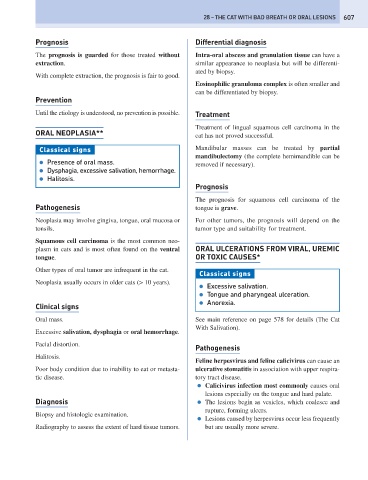Page 615 - Problem-Based Feline Medicine
P. 615
28 – THE CAT WITH BAD BREATH OR ORAL LESIONS 607
Prognosis Differential diagnosis
The prognosis is guarded for those treated without Intra-oral abscess and granulation tissue can have a
extraction. similar appearance to neoplasia but will be differenti-
ated by biopsy.
With complete extraction, the prognosis is fair to good.
Eosinophilic granuloma complex is often smaller and
can be differentiated by biopsy.
Prevention
Until the etiology is understood, no prevention is possible. Treatment
Treatment of lingual squamous cell carcinoma in the
ORAL NEOPLASIA** cat has not proved successful.
Classical signs Mandibular masses can be treated by partial
mandibulectomy (the complete hemimandible can be
● Presence of oral mass.
removed if necessary).
● Dysphagia, excessive salivation, hemorrhage.
● Halitosis.
Prognosis
The prognosis for squamous cell carcinoma of the
Pathogenesis tongue is grave.
Neoplasia may involve gingiva, tongue, oral mucosa or For other tumors, the prognosis will depend on the
tonsils. tumor type and suitability for treatment.
Squamous cell carcinoma is the most common neo-
plasm in cats and is most often found on the ventral ORAL ULCERATIONS FROM VIRAL, UREMIC
tongue. OR TOXIC CAUSES*
Other types of oral tumor are infrequent in the cat.
Classical signs
Neoplasia usually occurs in older cats (> 10 years).
● Excessive salivation.
● Tongue and pharyngeal ulceration.
● Anorexia.
Clinical signs
Oral mass. See main reference on page 578 for details (The Cat
With Salivation).
Excessive salivation, dysphagia or oral hemorrhage.
Facial distortion.
Pathogenesis
Halitosis.
Feline herpesvirus and feline calicivirus can cause an
Poor body condition due to inability to eat or metasta- ulcerative stomatitis in association with upper respira-
tic disease. tory tract disease.
● Calicivirus infection most commonly causes oral
lesions especially on the tongue and hard palate.
Diagnosis ● The lesions begin as vesicles, which coalesce and
rupture, forming ulcers.
Biopsy and histologic examination.
● Lesions caused by herpesvirus occur less frequently
Radiography to assess the extent of hard tissue tumors. but are usually more severe.

